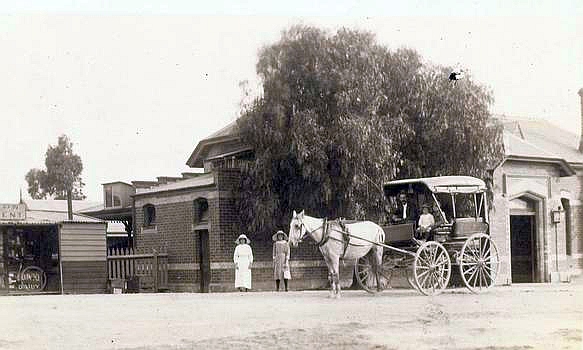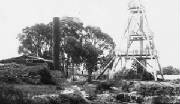|
|
 |
|
|
 |
|
|

|
| Ringwood to Warrandyte coach at Ringwood Station 1920 (SLV) |
RINGWOOD’S HISTORY
The
original Ringwood village emerged in the mid to late 19th century, following the
sale of land in the 1850s and the emergence of local grazing, fruit growing and
brick making activities.
The railway
The railway line from Melbourne commenced its
eastward development in 1861
when it reached Hawthorn. It was extended to Camberwell in April 1882 and the
final section, from Camberwell to Lilydale, opened as a whole in December 1882.
The line to Ferntree Gully followed.
The construction of the railway from Hawthorn
to Lilydale (through
Ringwood) resulted in a consolidation of township facilities, including local
churches, banks and schools to accommodate for a growing village and regional
population.
Reflecting the priorities of the time, the
first main building at the
station was a railway goods shed, built in 1887 to serve what would have been
predominantly a goods, rather than passenger, railway. In 1889, Ringwood Station
was erected at a cost of 1374 pounds and as a symbol of the increasing
importance of the township.
The borough of Ringwood was established in
1924, which coincided with the
electric railway line and subsequent development of a major township.
Post-war
Considerable suburban expansion during the
post-war period gave rise to the
declaration in 1960 of the City of Ringwood. At this point Ringwood gained
formal recognition as part of the broader metropolitan region, emphasised by the
erection of Eastland in 1967 as a major 'new format' retail Centre.
Ringwood was ceded from the Shire of Lilydale
and created a borough on 22
October 1924. It was officially proclaimed a borough on 13 December 1924.
Ringwood was proclaimed a city on 19 March 1960. On 15 December 1994 the City of
Ringwood was created.
On 15 December 1994, the City of Ringwood was abolished, and, along with the City of
Croydon, was merged into the City of Marondah]
Council meetings were held at the Municipal Offices, on Mines Road, Ringwood. It presently serves as the council seat
for the City of Maroondah.
(Abridged from articles at the Ringwood and District Historical Society
website and Wikipedia)
|
|

|
| Clock Tower during construction 1928 (SLV) |
The Clock Tower Ringwood is known for its clock tower. Conceived as a War Memorial after the Great War, the clock
tower was built in 1928 on the corner of Whitehorse Road (Main Street) and Warrandyte Road. It was formally
unveiled by the Mayor of the newly formed Borough of Ringwood, and not by military ceremony. The Clock Tower became an icon and, increasingly, a traffic hazard. With
the mooted development of Eastland Shopping Centre nearby, it was decided, after some controversy, to re-erect the Clock
Tower at the site of the former Cool Stores on the corner of Whitehorse Road and Wantirna Road. It was re-dedicated in December 1967.
|
|
Click here to see the Page about the Antimony Mine

|
| The Mine in 1920 (SLV) |
Mining Mining
of antimony commenced in Ringwood after its discovery in 1869. Antimony
was a sought after mineral in its time. It was used for making pewter, in
the manufacture of vulcanised rubber, as pigment in paint, for the manufacture
of medicines and in the printing industry. Today it is little-used and little-known.
Various mines operated generally south of Whitehorse Road and north of Mt
Dandenong Road Ringwood East, most notably Boardman's Mine in Mines Road, now
the site of Maroondah City Council offices. Mining took place during the 1870s
and into the 1880s although was generally discontinued after 1892. Brick works and tile works also operated
in the 1880s, producing bricks and terracotta roof tiles for an expanding
Melbourne. That enterprise was brought to an abrupt end by the recession of
the 1890s.
|
|

|
| Ringwood Exchange 1980s |
Post and
Telecommunications
Prior to completion of the railway line, all mail was delivered to Maroondah by coach
and horseback. The opening of the first post office in Maroondah, at Ringwood in 1875, coincides with commencement of a Cobb
& Co. service through the District, along the Lillydale Track (Maroondah Highway), the previous year. Mail for
Croydon is believed to have been dropped off daily by the service at a store near the present corner of Croydon Road and the
Maroondah Highway.
Two limited postal services possibly ran through Maroondah as early as 1865.
A Post Office Department report of the period describes them as: to and from Melbourne and Wood’s Point, by way of the
Yarra track and Matlock, three days a week and to and from Kew and Lillydale by way of Box Hill, Doncaster and Warrandyte..
This last route after leaving Warrandyte continued on to Brushy Creek, before finishing at Lilydale.
Croydon’s
first post office opened in 1885, at Croydon Railway Station. The advantage of the post office operating from the station
was its access to the railway’s telegraph circuit, as a post office telegraph line was yet to open through the district.
Similarly, Ringwood’s initial telegraph service was operated from the railway station, and commenced with the opening
of the Lilydale line in 1882 . Other services provided by the unofficial post offices included money orders, and agencies
of the Post Office Savings Bank.
The district’s first official Post Office opened at Ringwood
in 1913, on the corner of Whitehorse Road and Ringwood Street.
A telephone exchange opened at Ringwood
in 1912, and by 1922, an exchange was operating at Croydon, with 27 subscribers. Those who were fortunate enough to have a
telephone, were provided with a limited service, when compared with today’s standards and technology. It was not uncommon
for country telephone exchanges in the early years to be closed on Wednesday afternoons, lunch times and in the evenings.
An all-night exchange did not commence in Ringwood until 1939, and Croydon residents were still
required until 1960, to place trunk calls when telephoning Melbourne. In 1977, the Croydon Telephone District was established,
servicing an area with a population of 180,000 people.
The first automatic telephone exchange was commissioned
in 1956, in Ringwood St. It replaced a manual exchange. A long-line terminal was located in a small building opposite, carrying
trunk-line traffic to Warrandyte, Croydon, and Ferntree Gully. The author worked at the exchange during 1957 as a Trainee
Technician, PMG' s Dept!
|
(Above) Coach and Horses Hotel, 1875, Main Rd, later Maroondah Highway (SLV)
|
|
 |
|
|
 |
|
|
 |
|
|
|
|
|
|
 |

